
PREV ARTICLE
NEXT ARTICLE
FULL ISSUE
PREV FULL ISSUE
STACK'S BOWERS NOVEMBER 2016 RARITIES SALE
Here are some coins that caught my eye in the November 2016 Stack's Bowers Rarities Night sale.
Like many of us, I started out collecting my country's official coins. These are some beauties that I'd be proud to own.
-Editor
Lot 2001: 1793 Liberty Cap Half Cent. Head Left 
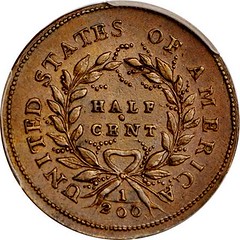
The obverse impression is drawn trivially to 3 o'clock and the reverse is rotated approximately 45 degrees clockwise from normal coin alignment, attributes that we have noted in several other 1793 half cents of the C-2 die pairing. A popular and historic issue, this is the United States Mint's premier half cent delivery and the only one of the Head Left Liberty Cap design type. This is one of the finest circulated survivors that we have ever had the privilege of bringing to auction...
To read the complete lot description, see:
Lot 2019: 1914-D Lincoln Cent 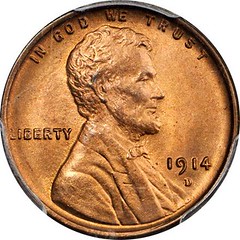

Although the 1909-S V.D.B. and 1931-S were produced in smaller numbers, the 1914-D is the rarest Lincoln cent issue (as opposed to variety or error) in Mint State. Despite having a relatively limited mintage (1.1 million pieces) in its own right, the 1914-D seems to have slipped quietly into circulation, with most coins remaining there until worn out or lost. Relatively few Mint State examples have survived, and most of those extant seem to have survived purely as a matter of chance.
To read the complete lot description, see:
Lot 2037: 1919 Buffalo Nickel 

In the years of peace following the Great War, production of nickels was dramatically increased. Over sixty million pieces were struck at Philadelphia alone, making this one of the most available of the early Buffalo nickels. But, as with some of the other earlier issues, this increase in production did come at a modest price. Die life was extended, and at times the quality of the strike suffered somewhat as a consequence. While not especially challenging to locate in uncirculated condition, specimens with strong strikes and considerable eye appeal are exceedingly challenging to obtain.
To read the complete lot description, see:
Lot 2071: 1916 Standing Liberty Quarter 
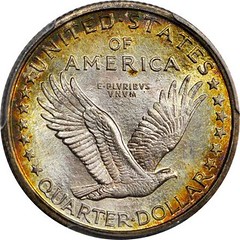
Mintage for this initial year of issue struggled to 52,000 pieces, a mere fraction of other prized rarities that are so well known today. Apparently the Philadelphia Mint received word that the new Standing Liberty quarter design was being adopted in late 1916 and a set of dies was prepared. Recall that Barber quarters were issued in significant numbers in 1916 from both the Philadelphia and Denver mints. These new 1916 Standing Liberty quarters were struck in the second half of December of that year and, all were released with the first batches of the new 1917 quarters in mid January. Most entered circulation with little fanfare, and stayed there. Thankfully a few were saved by alert collectors as the first of their kind. This exact coin is undoubtedly one of the very finest to survive, with a tiny population of four seen by PCGS with a single coin finer as MS-67+ FH of this key date issue.
To read the complete lot description, see:
Lot 2086: 1831 Capped Bust Half Dollar. Obverse 2 (O-103)--Full Brockage Obverse 
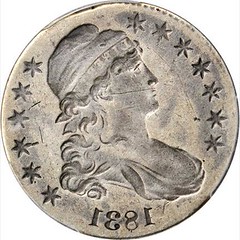
Offered here is an exceedingly rare and extremely important major early half dollar Mint error. The obverse is properly struck but off center a few degrees at 3 to 4 o'clock with no denticulation along the lower right border. The reverse, on the other hand, displays a full, well centered incuse mirror image from the obverse of another previously struck 1831 half dollar that had remained on the reverse die when the present example was struck. The error, known as a brockage, is rotated 180 degrees from normal coin alignment. The detail to the brockage is excellent, sharper than that seen on the obverse, which displays moderate wear appropriate for the VF grade from PCGS. Lovely golden-gray patina blankets the brockage side, while the obverse is a bit lighter silver gray. A short, thin scratch in the left obverse field before Liberty's nose is noted, as are a few equally trivial marks on Liberty's cheek and behind the portrait on the brockage side. Visually stunning and of the utmost rarity, this phenomenal coin would serve as the centerpiece in the finest collection of early half dollars and/or major Mint errors. There are only two full obverse brockage errors known for the entire early U.S. half dollar series, 1794 to 1836, and interestingly they are both examples of the 1831 Capped Bust issue.
To read the complete lot description, see:
Lot 2188: 1936-S Oregon Trail Half Dollar 

Ezra Meeker formed the Oregon Trail Memorial Association in an effort to raise funds ostensibly to place monuments along the length of the Oregon Trail to commemorate the pioneers who made the arduous and often dangerous journey westward. Meeker petitioned Congress to grant approval for a series of commemorative coins to fund these memorials, who readily agreed and quickly approved a bill on May 17, 1926 permitting no more than the astonishingly huge amount of six million half dollars. Married couple James Earle and Laura Gardin Fraser produced a dramatic and very attractive design that the Commission of Fine Arts quickly approved the design. Hubbing was performed by Medallic Arts Company and the first batch of 40,000 1926-dated coins were coined at the Philadelphia Mint in September. The coins proved to be an instant success and additional coins were struck at the San Francisco Mint. The initial flurry of sales quickly dwindled and large numbers remained unsold. Despite the Treasury Department's insistence that no more coins were to be struck until the existing coins were sold, the CFA had enough clout to compel additional coins to be struck in 1928, a large percentage of which sat unsold for five years. The remaining coins were melted down and a smaller quantity of 1933-dated pieces produced. Even though these proved to be a sales flop, more coins were authorized and more unsold coins ended up in the melting pot, a cycle that repeated in 1934, 1936, 1937, 1938, and finally 1939 when the series at last came to an end. While initially generous in quantities, the mintages dropped off sharply and the later issues are quite scarce. 5,000 of the half dollars were produced at the San Francisco Mint and were absorbed into the numismatic community at a cost of $1.60 a coin. Ultimately a total of 264,419 coins of all dates and mints were struck, far fewer than the authorized amount. The later dates are far rarer than the first two issues and were recognized as scarce at the time, often fetching decent premiums above the issue price. Even though the 1936-S half dollars were carefully preserved overall, Superb Gem examples pose a challenge for even the most determined classic commemorative specialist. Seldom encountered so fine and an exemplary representative for the issue.
To read the complete lot description, see:
Lot 2192: 1879 Pattern Morgan Dollar. Judd-1616 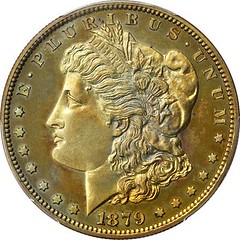
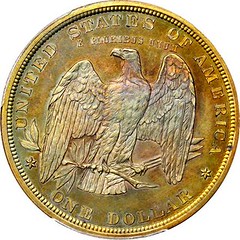
Obv: The same design that the Mint used to strike regular issue 1879 Morgan silver dollars. Rev: Eagle with spread wings clutches an olive branch in its right talon and three arrows in its left, both design elements extending behind the eagle's wings. The Latin motto E PLURIBUS UNUM is immediately above the eagle, the legend UNITED STATES OF AMERICA is around the border, and the denomination ONE DOLLAR is below. The surfaces are vivid golden-olive with bright gold, orange, rose and powder blue undertones, most varied on the reverse. Both sides are fully struck with a vibrant finish and outstanding visual appeal. This extremely popular type with both pattern specialists and Morgan dollar enthusiasts is attributed to George T. Morgan and was prepared as a possible alternative to the regular issue reverse; that eagle motif had met with criticism from some segments of the contemporary public. Struck in both silver and copper, examples of which are of equal rarity with more than a dozen known in each composition.
To read the complete lot description, see:
Lot 2193: Broadstruck 1922-S Peace Silver Dollar 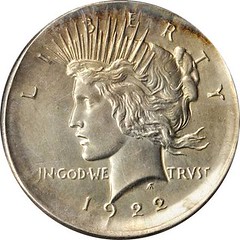
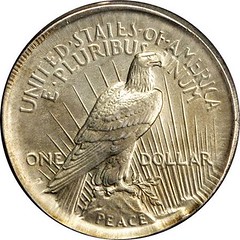
The spread to the planchet caused by the error is quite uniform on both sides and has resulted in only minimal differences between the width of blank planchet around the design. The detail is impressively sharp for most features, particularly in the centers where Liberty's hair tresses and the feathers at the junction of the eagle's wing and leg are very full for a San Francisco Mint Peace dollar. This phenomenon is often noted for broadstruck errors of other types, such as Mercury dimes on which the central crossbands are usually far better defined than those seen on properly struck examples. Errors of this type result when coins are struck in the absence of a retaining collar. If the collar becomes jammed on the shaft of the lower die with the top of the collar level with the die face, a broadstruck error will result. Without the collar to retain it, the planchet will spread and distort when struck by the dies. While we have handled a number of broadstruck errors for modern U.S. Mint types, this error is very rare in the Peace dollar series. With approximately six examples known, in fact, the broadstruck 1921 Peace dollar has been ranked #63 in the popular 2010 book 100 Greatest U.S. Error Coins by Nicolas P. Brown, et al. The first year status of the 1921 and its distinct High Relief design explain the inclusion of the 1921 in that reference, although this broadstruck 1922-S certainly emerges as one of the rarest and most significant errors known for the type.
To read the complete lot description, see:
Newman Numismatic Portal Partner of the Week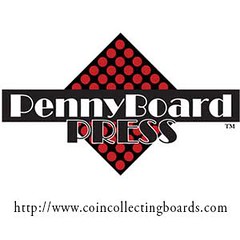
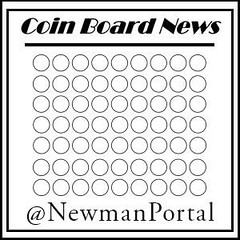 Wayne Homren, Editor Wayne Homren, Editor
The Numismatic Bibliomania Society is a non-profit organization promoting numismatic literature. See our web site at coinbooks.org. To submit items for publication in The E-Sylum, write to the Editor at this address: whomren@gmail.com To subscribe go to: https://my.binhost.com/lists/listinfo/esylum All Rights Reserved. NBS Home Page Contact the NBS webmaster 
|